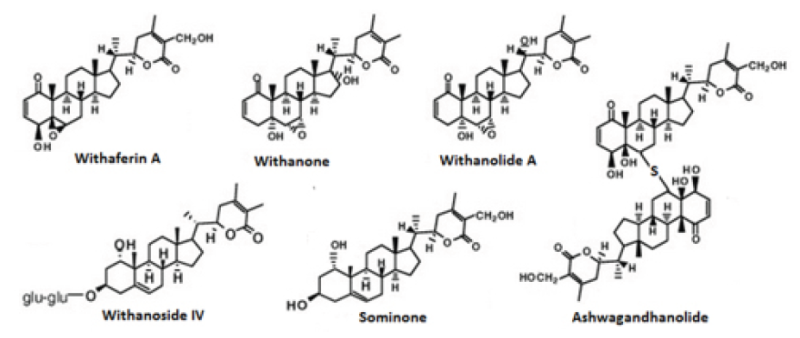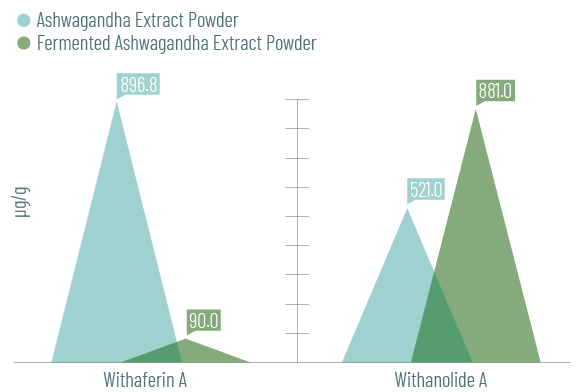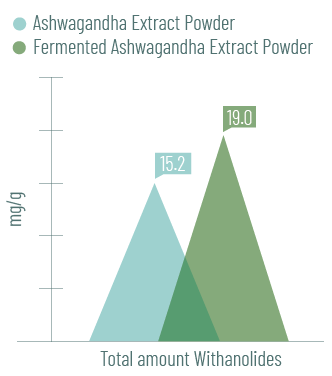Knowde Enhanced TDS
Identification & Functionality
- Active Component
- Ingredient Name
- Food Ingredients Functions
- Pharma & Nutraceuticals Functions
- Ingredients
- Ashwagandha
- Product Families
- Composition
100% Fermented organic ashwagandha root (Organic farming ashwagandha bio-processed by Lactobacillus plantarum)
- Chemical Structure of Components

Features & Benefits
- Benefit Claims (Health)
- Labeling Claims
- Food Ingredients Features
- Product Highlights
The root of ashwagandha contains many active compounds of which the following are the most important:
- Steroidal lactones (steroidal saponins) such as withanolides (A-D & Z), withaferin A, withanone
- Withanoside series of steroidal lactones (usually withanoside IV and VI), sominone (active metabolite and aglycon of withanoside IV)
- Withanolide glycosides (saponins), which are referred to as sitoindosides (or glycowithanolides)
- Alkaloids as a.o. isopelletierine, anaferine, cuscohygrine, anahygrine
- Ashwagandhanolide & withanolide sulfoxide
At present, more than 12 alkaloids, 40 withanolides, and several sitoindosides (a withanolide containing a glucose molecule at carbon 27) have been isolated and reported from aerial parts and roots of Withania species.
- Conversion of the glycolised saponines to the more active form
- Withaferin A is degraded by fermentation to a negligible level
- The content of withanolide A has been increased by about 70 %
- Formation of SOD-like substances or smaller active antioxidant molecules
- Much lower daily dose needed
- Health Benefits
- It has been shown to reduce stress and anxiety in both animal and human studies
- May improve brain function, memory, reaction time, and the ability to perform tasks
- May help lower cortisol levels in chronically stressed individuals.
- May be beneficial for normalizing thyroid indices in subclinical hypothyroid patients
- Helps increase testosterone levels and significantly boosts sperm quality and fertility in men
- It has been shown to lower blood sugar levels in several studies
- It has been shown to increase natural killer cell activity and decrease markers of inflammation
- Helps promote muscle strength, size and recovery
- Helps enhance cardiorespiratory endurance
Applications & Uses
- Markets
- Food & Nutrition Applications
- Use Level
- 100 - 300
Properties
- Appearance
- Brown - colored powder with characteristic odor
- Slightly Soluble in
- Water
- Physical Properties
- Active Ingredient
- Microbiological Values
- Heavy Metals
| Value | Units | Test Method / Conditions | |
| Moisture Content | max. 5 | % | - |
| Value | Units | Test Method / Conditions | |
| Withanolides | min. 1.5 | % | - |
| Withanolide A | min. 800 | mcg/g | - |
| Withaferin A | max. 50 | mcg/g | - |
| Value | Units | Test Method / Conditions | |
| Yeasts & Molds Count | max. 100 | cfu/g | - |
| Coliform | max. 100 | cfu/g | - |
| Escherichia coli | Negative | - | - |
| Salmonella spp. | Negative | - | - |
| Staphylococcus aureus | Negative | - | - |
| Listeria monocytogenes | Negative | - | - |
| Value | Units | Test Method / Conditions | |
| Arsenic Content | max. 1.0 | ppm | - |
| Lead Content | max. 1.0 | ppm | - |
| Mercury Content | max. 0.1 | ppm | - |
| Cadmium Content | max. 0.3 | ppm | - |
Regulatory & Compliance
- GMO Status
FermanolideTM does not consist of, nor contains, nor is produced from genetically modified organisms (GMOs).
- Allergens Profile
Substances causing allergies Yes No Milk x Soy x Eggs x Fish x Cereals gluten x Celery x Mustard x Nuts x Peanuts x Sesame seeds x Lupin x Molluscs x Crustaceans x Sulfur Dioxide x Refer to Regulation (EU) No 1169/2011
Technical Details & Test Data
- Why Fermenting Ashwagandha
- Biotransformation of secondary plant substances
The most active components of ashwagandha are the withanolides, withanosides and glycowithanolides, all calledsaponins. The focus is mainly on the conversion of the original glycolised saponines to the more active form through our proprietary lactic acid fermentation. Due to their bulky molecular structures, the saponins are poorly membrane permeable and prone to degradation. The mass of the original withanolides, withanosides and glycowithanolides decreases after fermentation due to the removal of the sugar molecules. This process is called deglycosylation. The form is the so called aglycone form, which is permeable and hence directly bioactive. Smaller molecules that are very active and well-studied, penetrate the body more easily - Withaferin A is degraded by fermentation to a negligible level and therefore there is no risk of cell toxicity
A specific probiotic strain in the fermentation process is able to break down withaferin A. Its genotoxic potential should be carefully considered for functional foods and dietary supplements. The amount of withaferin A in Fermanolide™ is less than 0.01%, making it very safe for human consumption. - The flavonoids are broken down into smaller active antioxidant molecules by fermentation
Formation of SOD-like substances that are not destroyed in the digestive tract and perform the same function as superoxide dismutase (SOD) - The content of withanolide A has been increased by about 70 % after fermentation at a stable level to ensure functional physiological activity.
A study shows that in addition to the strong antioxidant property, withanolide A provides increased neuroprotection by modulation of endogenous glutathione content in hippocampus during exposure to hypobaric hypoxia. Withanolide A increases glutathione biosynthesis in neuronal cells by upregulating GCLC level through Nrf2 pathway in a corticosterone dependent manner.

- The total withanolides content has been increased by 25%
A targeted lactic acid fermentation process ensures a substantial increase in the total withanolides content.

- Much lower daily dose needed
By the high bioavailability & rapid absorption in the small intestine and the fact that the biotransformed molecules are more stable & stay in the body for at least five days, a daily dose of 150 mg is under normal circumstances enough - Science
Many studies show the therapeutic properties of ashwagandha. It is therefore scientifically very well founded. However, it is important that the saponins are available in their easily absorbable form because this is a condition for the therapeutic power of this promising plant.
- Biotransformation of secondary plant substances
Packaging & Availability
- Packaging Information
- 1 kg sealed in an aluminum foil bag
- 1-20 bags packed in a corrugated box
Storage & Handling
- Shelf Life
- min. 2 Years
- Storage & Shelf Life
- Due to the hygroscopic nature, please store at dry conditions in an airtight container.
- Shelf life is at least two years at 25°C and below 70% RH in original sealed package.

